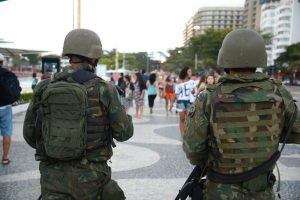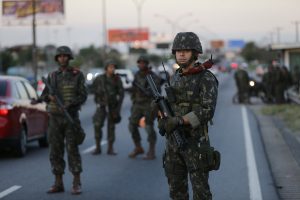Brazil Deploys 8,500 Armed Forces in Rio de Janeiro
Officials say the Armed Forces will be used across Rio in an effort to stem escalating violence and crime which has plagued the city.
By Jay Forte, Contributing Reporter
RIO DE JANEIRO, BRAZIL – The government announced yesterday (July 28th) that the implementation of the National Security Plan in Rio de Janeiro will employ 8,500 members of the Armed Forces, 620 members of the National Security Force and 1,120 of the Federal Highway Police, in an effort to improve security.

According to the commander of the operation, General of the 1st Army Division, Mauro Sinott, the use of the Armed Forces can be deployed at any time and there will be no routine, neither schedules nor locations.
This comes a day after Defense Minister Raul Jungmann described the federal efforts as ‘focusing on three pillars: integration, intelligence and surprise’, but also saying there will be no ostentatious presence of the Armed Forces occupying the streets, according to a government news source.
In the wake of the economic crisis and breakdown of the security in Rio, including the UPP program, federal authorities are taking a new tack. Looking to avoid a costly occupation effort, Jungmann confirmed that “The menu is any and every action that is needed to strike and take away the capacity of the [drug] trafficking.”
Shortly after signing a decree authorizing the use of the Armed Forces in the state, President Michel Temer commented on the decision. In a video posted on the president’s official Twitter account, he opened the message stating that military employment is supported by the Federal Constitution.
Directing his speech to the residents of Rio de Janeiro, he justified the decree citing the severity of the public security crisis in the state. “The purpose of the mission is to defend the integrity of the population, preserve public order and ensure the functioning of institutions.”

Rio’s Governor Luiz Fernando Pezão said yesterday, that “We are doing a great job of integration. Last night I called President Temer and he promptly answered my request for the Armed Forces.”
“The state will be strengthened in this partnership with the federal forces supporting our [police] in this confrontation. I am sure that with this integration we will be able to fight organized crime more strongly,” said Pezão.
The Armed Forces are already operating in the streets and avenues of Rio’s Metropolitan Region. From early afternoon, Army soldiers were stationed at strategic points, supported by motorcycles, jeeps and even armored, check-points stopping suspicious cars and inspecting documents.
At the junction of the Linha Vermelha and Rodovia Washington Luiz (BR 040), two vital routes for the metropolitan area, men of the 26th Parachute Infantry Battalion set up a monitoring station to monitor vehicles.
According to the captain who commanded the operation, there is no specific time limit for that mission and at any moment they could be deployed to another location in the city.
Although the road blitz increased traffic congestion, government news reports say the drivers did not appear to be upset and some even honked and waved, demonstrating support for the military.
The National Security Plan operation in Rio de Janeiro will continue until the end of 2018. The last time federal troops were in Rio was before Carnival last year, and before then for the 2016 Olympics and 2014 World Cup.
Economic freedom index 52%, third from worst category.
Brazil: Economy
Gross Domestic Product (GDP) [1]
| GDP, PPP (current international) | $3,141,333,107,725 (2016) |
| GDP Growth Rate (annual %) | -3.595% (2016) |
| GDP Per Capita, PPP (current international) | $15,128 (2016) |
GDP PPP, Billions USD - Last 5 Years
GDP Country Rank7/194 (2016)
Economic Indicators [1]
| Inflation, consumer prices (annual %) | 8.739% (2016) |
| External debt stocks, total (DOD, current US$) | $543,399,361,000 (2015) |
| Total tax rate (% of commercial profits) | 68.4% (2016) |
| Real Interest Rate (5 year average %) | 40.401% (2016) |
| Manufacturing, value added (% of GDP) | 11.714% (2016) |
| Current Account Balance (BoP, current US$) | ($23,529,633,120) (2016) |
Inflation, % - Last 5 Years
Labor and Employment [1]
| Labor Force, Total | 107,571,331 (2016) |
| Employment in Agriculture (% of total employment) | 10.29% (2015) |
| Employment in Industry (% of total employment) | 22.2% (2015) |
| Employment in Services (% of total employment) | 77.34% (2015) |
| Unemployment Rate | 11.452% (2016) |
Labor Force - Last 5 Years
Trade [1]
| Imports of goods and services (current US$) | $217,795,930,066 (2016) |
| Exports of goods and services (current US$) | $224,312,410,433 (2016) |
| Total Merchandise Trade (% of GDP) | 18.303% (2016) |
| FDI, net inflows (BoP, current US$) | $78,928,533,472 (2016) |
| Commercial Service Exports (current US$) | $32,567,703,439 (2016) |
Imports, Millions USD - Last 5 Years
Economic Snapshot [1]
Note: Percentile ranks are calculated using the latest available data for all countries within the last 5 years.
How to interpret the graph: The purpose of this graph is to take a snapshot of a country’s economy in comparison to other economies. For example, Brazil’s Exports rank is higher than 87.17% of the countries in the dataset. For Exports, FDI and GDP measures, a higher rank (closer to 100%) indicates a stronger economy. Conversely, for Unemployment and Inflation, a lower rank (closer to 0%) indicates a stronger economy.

No comments:
Post a Comment